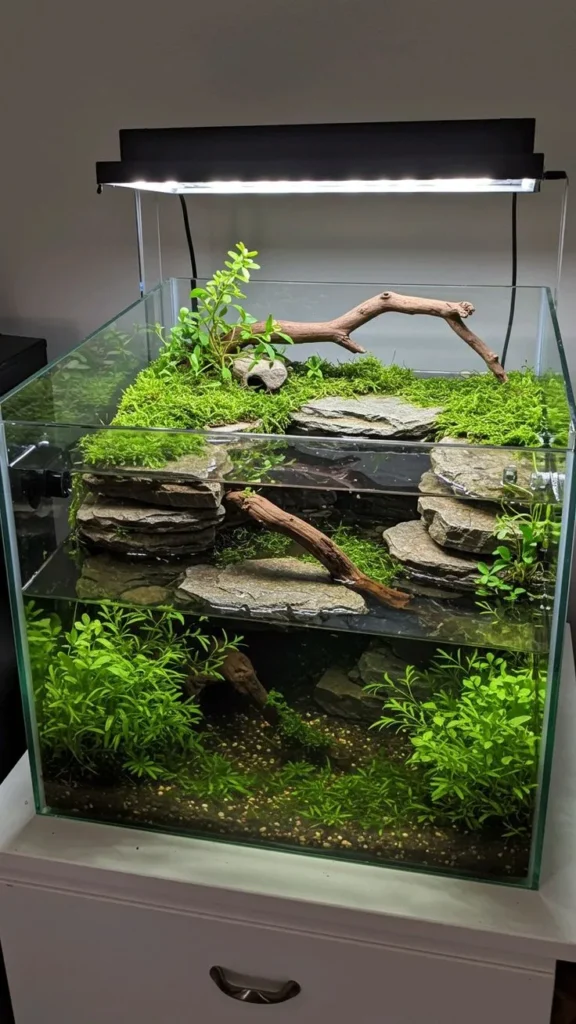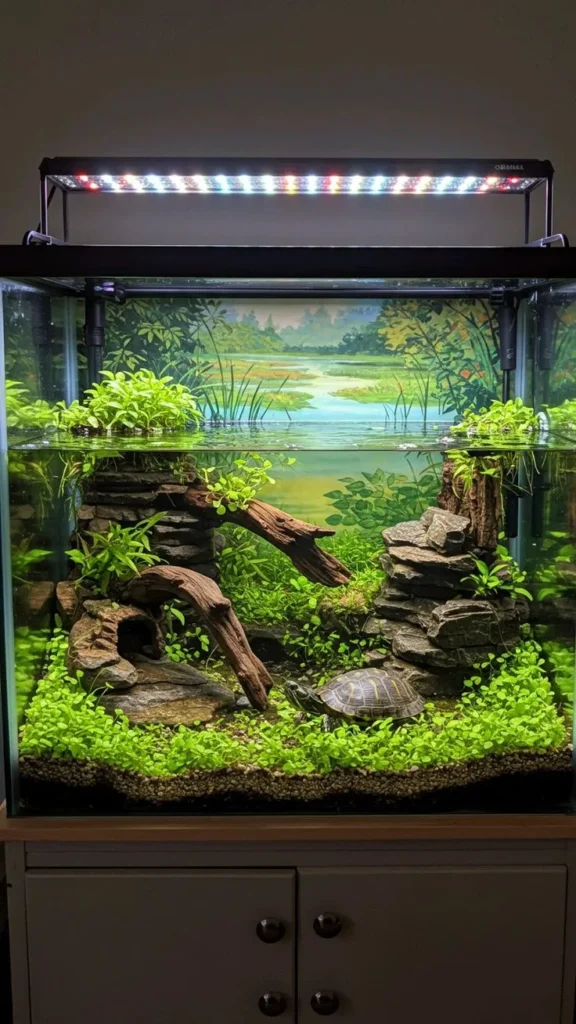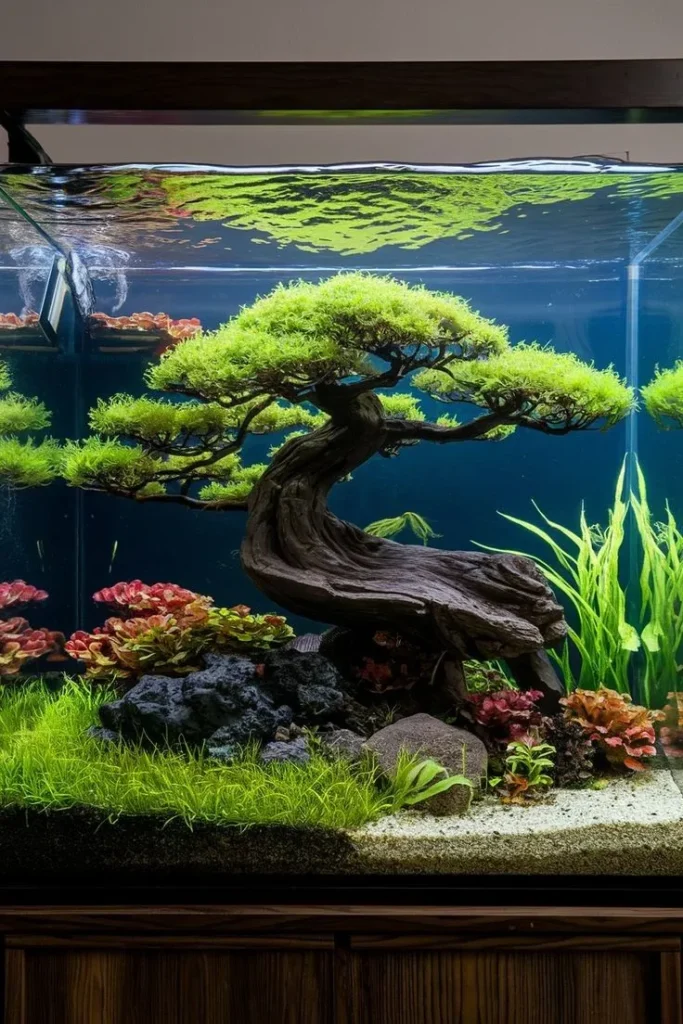When I first set up a pet turtle habitat, as turtle tank for beginners I realized how much thought goes into the turtle tank beyond just water and glass. People often underestimate aquatic care and the balance of both land and water, yet the rule of 10 gallons per 1 inch shell becomes a baseline every beginner should know. What fascinated me was how different experts bring in a setup guide, drawing on years of working with turtle experts who emphasize tank essentials like depth, lighting, and maintenance.
Through trial and error, I began developing my own flow of setup, focusing on habits that keep cleaning sustainable. Small things like monitoring happiness, creating a safe tank enclosure, and applying cleaning tips became part of my weekly routine. Even the emotional connection with a shelled friend grows when you follow a structured process. Having a step-by-step approach is less about intimidation and more about confidence, and it’s what transformed my early frustration into excitement.

Tank Size / Water Depth / Space turtle tank for beginners
Many keepers jump straight into aesthetics, but the critical decision is always tank size and shell length considerations. The measurement of 10 gallons per inch shell sounds simplistic, but when you actually measure a 13 cm or 5 inch turtle, suddenly the space requirement becomes obvious. My first 90 cm tank felt huge, yet I quickly noticed how an adult turtle uses every inch.
Later, I began experimenting with enclosure layouts, making sure a turtle could cover 4–5 body lengths before a turn. Adequate swimming freedom combined with a 3–4 width ratio and proper water depth of 1.5x length or even 2x body length prevents boredom and stress. Designing with turning space in mind ensures natural movement, something overlooked until you observe it in real time.
Land + Basking Area
Every successful enclosure blends land with water, and the highlight of that transition is a dedicated basking platform. My first attempt used random rocks, but I soon realized that a dry area with a ramp encourages consistent climbing behavior. I noticed semi-aquatic species spend almost 50 percent of their time on land, while fully aquatic ones need closer to 25 percent.
The ideal basking spot becomes a combination of elevated platforms, stable driftwood, and carefully placed decor. When turtles rest on platforms that are both accessible and safe, the tank begins to replicate natural shorelines. Balancing safety and stability with comfort proved to be just as vital as providing swimming space, and it remains one of the most rewarding design choices I ever made.

Heating, Lighting & Temperature
Without UVB lighting, I watched my turtle’s shell health deteriorate, teaching me why calcium absorption matters more than casual keepers realize. Combining heat lamps to maintain basking temperature between 85–95°F with a water heater at 75–85°F creates a dynamic yet stable rhythm. I once failed to track the gradient, leaving the cooler side at just 75°F, and saw immediate behavioral changes.
Now I rely heavily on thermometers for temperature monitoring, ensuring both heating and lighting are in sync. The entire enclosure transforms into a controlled microclimate, balancing bone health with comfort. This isn’t about luxury; it’s about replicating what turtles instinctively seek in the wild.
Filtration & Water Quality
The first time I underestimated turtle mess, my weak filter collapsed. Upgrading to a canister filter or power filter with a strong filter capacity changed everything. Following the flow rate rule of 4x tank volume — meaning 200 gph for a 50-gallon setup, ensured real stability. I also checked the inlet and outflow design so the turtle didn’t get trapped or stressed.
Adding a bacteria starter during cycling allowed colonies of beneficial bacteria to stabilize water quality faster. Regular water testing for pH, ammonia, nitrite, and nitrate helped me keep parameters in range, with pH 6–8, ammonia 0, and nitrate <40 ppm as safe limits. When those numbers drift, the turtle feels it first, and that’s why filtration remains non-negotiable.

Cleaning & Water Changes
The discipline of daily cleaning begins with removing debris before it piles up. I started with a strict weekly ritual of 25–50 percent water change while scrubbing buildup off surfaces. Then, on a monthly schedule, I committed to full substrate cleaning and adjustments. When neglected, I saw bacterial blooms escalate rapidly.
To sustain long-term stability, I adopted deep cleaning every 2–3 months, targeting both the filter and hidden corners. Using a dechlorinator or water conditioner during refills is mandatory, but equally important is rinsing media in old tank water to protect beneficial bacteria preservation. That practice alone saved me from repeated ammonia spikes.
Substrate & Decoration
Choosing gravel or pebbles without thought invites a choking hazard or digestive risk, and experimenting with sand only led to clog filters and blockages. I now rely on slate, large rocks, or even bare-bottom tanks, combining them with selective driftwood and aquatic plants. The right decor preserves swimming space, while basking platforms, ramps, and secure placement make the design both natural and safe.
Location of Tank
A strong surface matters because a filled aquarium is deceptively heavy. Always keep it on a level surface that can handle full weight support. Positioning near windows exposed mine to direct sunlight, creating overheating and rapid algae growth. Careful tank placement is a detail that defines success.
Diet & Feeding
Staples like pellets mixed with vegetables and occasional insects form the most practical staple diet. Observing feeding time taught me that variety beats excess, and thoughtful feeding avoids both stress and waste.
Handling & Safety
Consistent handling must be minimized for safety, as turtles can carry salmonella. I always wash hands immediately, and I never attempt species mixing, since avoiding cohabitation prevents unnecessary aggression.

FAQs
What is the best tank size for a beginner turtle?
The best size follows the 10 gallons per inch shell rule. A small 5 inch turtle needs at least a 90 cm tank, and as the adult turtle grows, you may upgrade for more swimming and turning space.
How deep should the water be in a turtle tank?
Experts recommend a water depth of about 1.5x to 2x body length. This ensures the turtle can swim freely while preventing stress.
Do turtles really need a basking area?
Yes, every pet turtle needs a basking spot that is dry, elevated, and accessible. Semi-aquatic turtles spend up to 50 percent on land, while fully aquatic ones average 25 percent basking.
What kind of lighting does a turtle tank need?
A combination of UVB lighting and heat lamps is essential. UVB supports calcium absorption, shell health, and bone health, while basking areas should stay between 85–95°F.
What temperature should the water be for turtles?
Keep the water stable with an aquarium heater at 75–85°F, and ensure the cooler side of the enclosure remains around 75°F. Use thermometers for constant temperature monitoring.
How important is filtration in a turtle tank?
A strong filter, such as a canister filter or power filter, is critical because turtles are messy. Follow the flow rate rule of 4x tank volume (e.g., 200 gph for a 50-gallon tank).
What water quality parameters should I check?
Check pH (6–8), ammonia 0, nitrite low, and keep nitrate <40 ppm. Use a bacteria starter and regular water testing to stabilize conditions.
How often should I clean a turtle tank?
Do daily cleaning for debris, a weekly water change of 25–50 percent, and monthly substrate cleaning. Every 2–3 months, do a deep cleaning of the filter and tank.
Is substrate necessary in a turtle tank?
Substrate is optional. Avoid gravel, pebbles, or sand that cause choking hazard, digestive risk, or clog filters. Safer choices include slate, large rocks, or going bare-bottom.
What decorations are safe for turtles?
Use driftwood, aquatic plants, stable ramps, and secure basking platforms. Always maintain open swimming space and ensure secure placement.
Where should I place my turtle tank?
Keep the tank on a strong surface and level surface that supports full weight. Avoid windows or direct sunlight to prevent overheating and algae growth.
What do turtles eat in captivity?
A healthy staple diet combines pellets, fresh vegetables, and occasional insects. Overfeeding or lack of variety can harm digestion and growth.
Is it safe to handle turtles?
Limit handling for safety. Turtles may carry salmonella, so always wash hands afterward. Also avoid species mixing or cohabitation to prevent aggression.
Do turtles need a water conditioner?
Yes. Always use a dechlorinator or water conditioner when refilling the tank, since untreated tap water can harm your turtle and kill beneficial bacteria.
Can turtles live with fish in the same tank?
Generally no. Most turtles will eat or harass fish, making them incompatible tank mates.
How can I prevent algae growth in my turtle tank?
Avoid direct sunlight, perform regular cleaning, and use proper filtration. Algae thrive with excess nutrients and poor water balance.
Do turtles need thermometers in their tanks?
Yes. Place thermometers on both the basking area and water to ensure precise temperature monitoring.
Can baby red-eared sliders use gravel substrate?
Use only large pebbles that are too big to swallow. Smaller pieces pose a swallow risk and should be avoided.
Why is cycling important in a turtle tank?
Adding a bacteria starter during the cycling process establishes beneficial bacteria colonies. This keeps ammonia and nitrite low while stabilizing overall water chemistry.
Pingback: What Colors Are Turtles? 7 Fascinating Facts & Variations